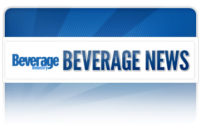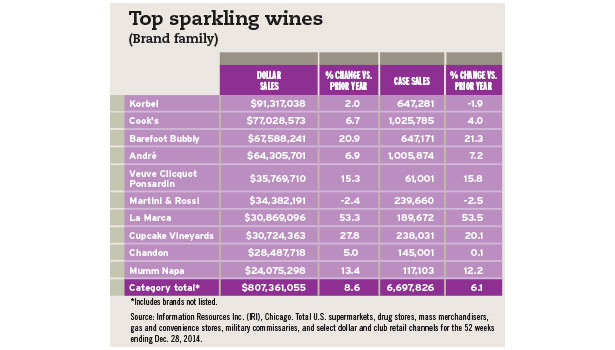Sparkling and premium wines driving category growth
Interest in new taste profiles helps imported wine sales








On award show night, many celebrities seem to sparkle as they walk the red carpet. In the U.S. wine market, sparkling wines also seem to be garnering consumer attention.
Eric Penicka, U.S. analyst with Euromonitor International, Chicago, notes that sparkling wines that are not Champagnes saw strong growth in 2013, with Prosecco up 28 percent and Moscato up in the mid-teens. “Those types of wines as well as other sparkling wines, domestic sparkling wines as well as red sparkling wines out of Italy are really popular,” he says. “That’s partially driven by the price point being lower than that of Champagnes.”
Penicka adds that because sparkling wines tend to have a sweeter profile than Champagnes, more consumers have gravitated toward them.
Danelle Kosmal, vice president of the beverage alcohol practice at New York-based Nielsen, also notes the contribution sparkling wines have made to the U.S. wine market. In Nielsen-measured off-premise channels excluding ecommerce, sparkling wines were up 4.6 percent in 2014, with domestic up 1.9 percent and imported posting growth of 8.2 percent, she says. However, imported sparkling wines account for a much smaller portion of the total U.S. sparkling wine segment, Kosmal explains.
According to Information Resources Inc. (IRI), Chicago, sparkling wine and Champagne dollar sales increased 8.6 percent, totaling more than $807 million for the 52 weeks ending Dec. 28, 2014, in supermarkets, drug stores, mass merchandisers, gas and convenience stores, military commissaries, and select dollar and club retail channels. Volume sales also were up with the segment posting a 6.1 percent increase.
These growth numbers are reflective of how the segment has performed between 2009 and 2014. According to Chicago-based Mintel’s October 2014 report “Wine – US,” Champagne and sparkling wine saw the largest percentage of sales growth in that five-year time frame, increasing nearly a quarter. However, the report notes that it still accounts for only 5 percent of the overall wine category volume.
The market research firm does note that the segment has the potential for more growth. Citing its May 2014 report “Alcoholic Beverage Drinking Occasions – US,” Mintel found that nearly half of respondents aged 25 to 34 reported drinking sparkling wine or Champagne at home. “The smaller segment may focus attention on staying with these drinkers as they age, in order to match the relevance of table wine through the years,” the report states.
Euromonitor’s Penicka also anticipates more opportunities for sparkling wine. “Sparkling wines [are predicted] to continue to be the [fastest] growing, with the increase of Proseccos coming into more casual drinking; they’re pretty casual already but [are expected to be] even more so in the future,” he says.
Quality appeal
Although sparkling wine has posted strong numbers, the segment isn’t the only bright spot for the wine category.
In IRI-measured channels, table wine dollar sales increased 4.5 percent totaling $9.2 billion, while its volume sales were up just more than 2 percent in the 52 weeks ending Dec. 28, 2014.
Euromonitor’s Penicka adds that overall the wine category has seen consistent 3-4 percent growth in recent years. “Wine really is one of those things where it gains more and more interest as the years go on or because broad eating and food trends and drinking trends are really focusing in on more quality products,” he says.
One area that is helping to drive the purchase of high-quality wines is the millennial demographic, Penicka notes.
“Historically, wine has kind of been for older demographics in part because of its costs and in part because it’s not really a party drink, but now millennials [with] that kind of mentality of caring about what they’re eating and caring about quality, they’re attracted to it as well,” he says.
Some of this trend toward more premium wines can be found in the price-point purchases. Nielsen’s Kosmal says that table wines that are less than $8 represent most of the U.S. volume sold; however, it is the only price tier that has declined in the past three years. For instance, volume sales were down 1.6 percent last year.
“All other price tiers continue to grow,” she says. “The second-largest price tier presents wines $8 to $10.99, and that segment grew 5.2 percent in volume in 2014. While still relatively small, the $20 to $29.99 price-tier segment grew the most last year, up 15.2 percent compared to 2013.”
This trend also could fare well for the wine category as the economy continues to rebound. “With the resurgent economy, we expect to see wine sales continue to grow,” Kosmal says. “We could also expect to see additional premiumization of wine as the economy bounces back, allowing consumers [to] trade up to higher price tiers in wine.”
However, she notes that the premium market is not the only way that wine is appealing to consumers. “Unlike the premiumization happening in beer and spirits, wine is innovating across all price tiers, offering new options at all price levels for different types of consumers,” Kosmal says.
A world of options
In the United States, domestic wine options continue to account for a majority of sales, with table wine volume equating to approximately three-quarters versus roughly 25 percent for imported table wines, Kosmal says.
Of the regions in the United States, California domestic table wines account for 70 percent of off-premise sales, with Washington and Oregon trailing the golden state, Kosmal notes. However, Washington wine sales saw the most growth last year with an increase of
7.3 percent, she adds.
Noting the prominence of California wines, Euromonitor’s Penicka says Chardonnay remains the most popular varietal year-over-year because of the amount of production that comes out of the state. Nielsen’s Kosmal also named Chardonnay as the top-selling varietal based on volume with Cabernet Sauvignon, Pinot Grigio/Gris and Merlot following. Although Chardonnay remains in the top spot, it is not among the fastest growing. “The fastest growing varietals are red blends, Cabernet Sauvignon, Pinot Grigio and Pinot Gris, and Moscato,” she says.
Also noting the prominence of domestic wine sales, Euromonitor’s Penicka says its share is slowly starting to slip in the last decade as imports began to become more popular. “That’s kind of driven in part by interest in quality and interest in taste profiles and different products and experimentation with what wines are available,” he says. “A lot of people are familiar with what kind of wines come out of Napa, but maybe they’re not so familiar with the huge list of wines that you can get out of France and Italy and Slovenia [and] the smaller countries as well.”
Wines from Southern Hemisphere countries like Chile, Argentina and Australia have seen the most growth because of their quality and lower price point, Penicka says. However, consumers also are looking for new tastes, so wines from Italy and France have grown as well, he adds.
Nielsen’s Kosmal also notes the popularity of Chilean, Argentinian and Australian wines, with Australia accounting for 10 percent of table wines in the United States. However, she adds that each region-segment experienced volume declines in 2014, while Italian wines were up less than a percentage point. New Zealand had the strongest growth of imported wines with volume up 14.3 percent in 2014.
Looking for a reprint of this article?
From high-res PDFs to custom plaques, order your copy today!









